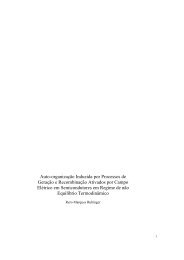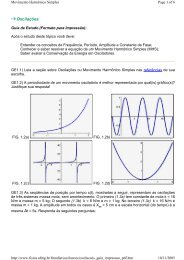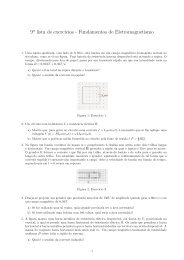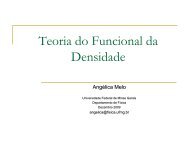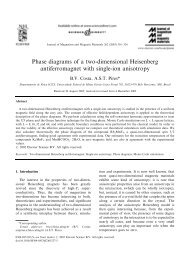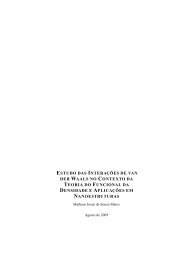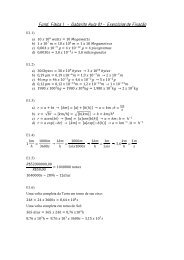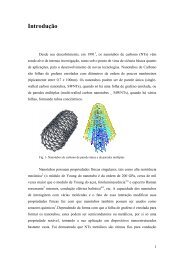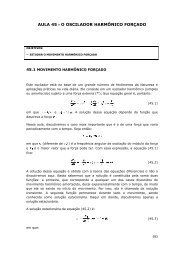- Page 1 and 2:
FUNDAMENTOS DE FÍSICA III© Todos
- Page 3 and 4:
© 2010, Wagner Corradi; Rodrigo Di
- Page 5 and 6:
A6.3 FERRAMENTAS MATEMÁTICAS: CÁL
- Page 7 and 8:
UNIDADE 8 - CAMPO MAGNÉTICOUNIDADE
- Page 9 and 10:
PrefácioA elaboração deste livro
- Page 12 and 13:
situações mais elaboradas que exi
- Page 15 and 16:
AULA 1 : CARGAS ELÉTRICASOBJETIVOS
- Page 17 and 18:
possuem uma quantidade natural de u
- Page 19 and 20:
indicar o comportamento do corpo ao
- Page 21 and 22:
então que houve apenas uma transfe
- Page 23 and 24:
As condições ambientais também p
- Page 25 and 26:
seus elétrons em excesso migrarão
- Page 27 and 28:
Ao contrário da eletrização por
- Page 29 and 30:
esfera. Dado que a carga total é c
- Page 31 and 32: ATIVIDADE 1.8Considere novamente as
- Page 33 and 34: RESPOSTAS COMENTADAS DAS ATIVIDADES
- Page 35 and 36: elétrica entre cargas e a distanci
- Page 37 and 38: aproximam ou se afastam. De fato, s
- Page 39 and 40: AULA 2: LEI DE COULOMBOBJETIVOS•
- Page 41 and 42: em que ε0é uma outra constante de
- Page 43 and 44: definida como a carga que, colocada
- Page 45 and 46: como mostrado na Figura 2.2.Figura
- Page 47 and 48: cos α = a/a 2 = 1/2,e1 Q4 πε02aF
- Page 49 and 50: F14πk εQQ1 2=20 rrˆ.(2.5)Uma man
- Page 51 and 52: RESPOSTAS COMENTADAS DAS ATIVIDADES
- Page 53 and 54: Podemos escolher qualquer ponto na
- Page 55: UNIDADE 2CAMPO ELÉTRICOSe uma corp
- Page 58 and 59: agente físico, com existência ind
- Page 60 and 61: 3.2 Distribuição de cargas elétr
- Page 62 and 63: em que x = 0, 50 m é a distância
- Page 64 and 65: Vetorialmente, podemos escrever que
- Page 66 and 67: 1867) como uma maneira de visualiza
- Page 68 and 69: F QEa = =(3.14)m mNote que a aceler
- Page 70 and 71: O vetor velocidade da carga ao se c
- Page 72 and 73: 2( Q + q)x − 2QLx+ QLque, desenvo
- Page 74 and 75: informações na literatura e compa
- Page 76 and 77: Figura 4.1: Problema geral do cálc
- Page 78 and 79: x = ,(4.7)areescreva sua resposta e
- Page 80 and 81: Vamos agora resolver o mesmo proble
- Page 84 and 85: Uma nova substituição de variáve
- Page 86 and 87: RESPOSTA COMENTADA DAS ATIVIDADES P
- Page 88 and 89: Aqui precisamos ter cuidado: como x
- Page 90 and 91: A densidade volumétrica de cargas
- Page 92 and 93: dEdqλ4π εRdθ′2 2( R + z )= 20
- Page 94 and 95: Atividade 5.2Qual é a força exerc
- Page 96 and 97: Figura 5.4: Disco plano com distrib
- Page 98 and 99: vem:rP− r = −rsenθcosφiˆ−
- Page 100 and 101: Depois de usar a equação 5.7 no d
- Page 102 and 103: E vemos portanto que o campo elétr
- Page 104 and 105: A direção da força é radial e o
- Page 106 and 107: P2.8) Um elétron com velocidade8v
- Page 108 and 109: 107
- Page 110 and 111: Devido ao fato do campo decair com2
- Page 112 and 113: em primeiro lugar, ele não é para
- Page 114 and 115: ATIVIDADE 6.2Determine qual é o fl
- Page 116 and 117: no caso da carga puntiforme: o mód
- Page 118 and 119: Atividade 6.3Verifique a lei de Gau
- Page 120 and 121: PENSE E RESPONDAPR6.1) Uma esfera c
- Page 122 and 123: ∫ Er ⋅ nda ˆ = E ⋅ 4πRVamos
- Page 124 and 125: 7.2 APLICAÇÕES DA LEI DE GAUSSVej
- Page 126 and 127: cada elemento infinitesimal de volu
- Page 128 and 129: se negativamente carregada. Qual é
- Page 130 and 131: erE ⋅ˆn = 0(na superfície).Port
- Page 132 and 133:
ou:qE =4πε0RaP3( 0 < r < a)Para a
- Page 134 and 135:
1 qΦ =38ε0ATIVIDADE 7.4Sobre cada
- Page 136 and 137:
Figura 7.13: Cavidade esférica no
- Page 138 and 139:
Figura 7.15 Experiência com interf
- Page 140 and 141:
Figura 7.19: Ângulo do campoAssim
- Page 142 and 143:
RESPOSTAS COMENTADAS DAS ATIVIDADES
- Page 144 and 145:
consideramos esse problema somado c
- Page 146 and 147:
ATIVIDADE 8.3A figura 8.3 mostra um
- Page 148 and 149:
ATIVIDADE 8.7Em uma placa fina, inf
- Page 150 and 151:
RESPOSTAS COMENTADAS DAS ATIVIDADES
- Page 152 and 153:
ada por ela é nula, o campo fora d
- Page 154 and 155:
E =σ2ε0.Dividindo 8.2 por 8.1 e s
- Page 156 and 157:
APÊNDICE A - SISTEMA INTERNACIONAL
- Page 158 and 159:
APÊNDICE B - CONSTANTES NUMÉRICAS
- Page 160 and 161:
APÊNDICE C - FATORES DE CONVERSÃO
- Page 162 and 163:
GEOMETRIAComprimento de uma circunf
- Page 164 and 165:
SINAIS E SÍMBOLOS MATEMÁTICOS= é
- Page 166:
REFERÊNCIAS BIBLIOGRÁFICASALONSO,



